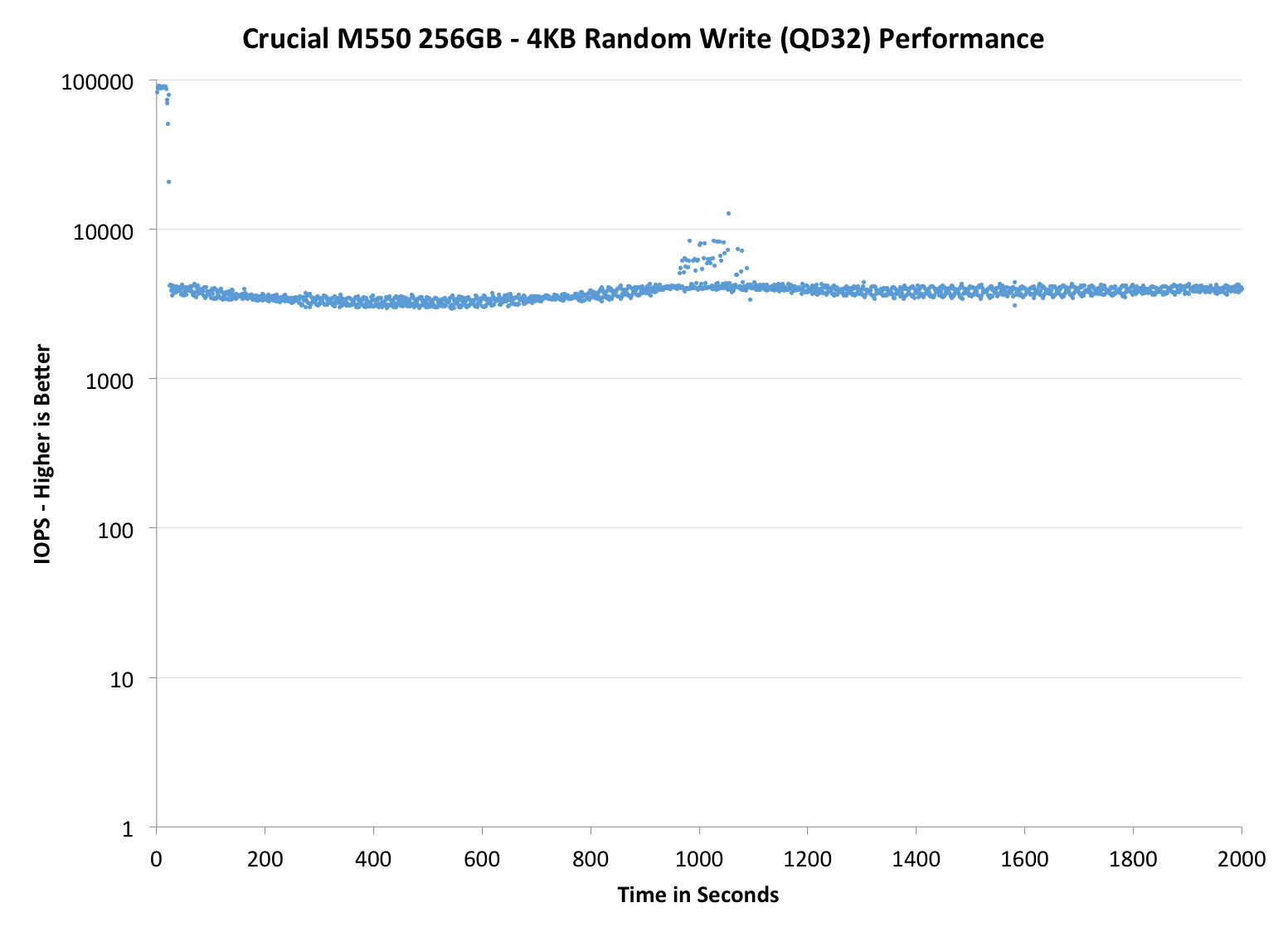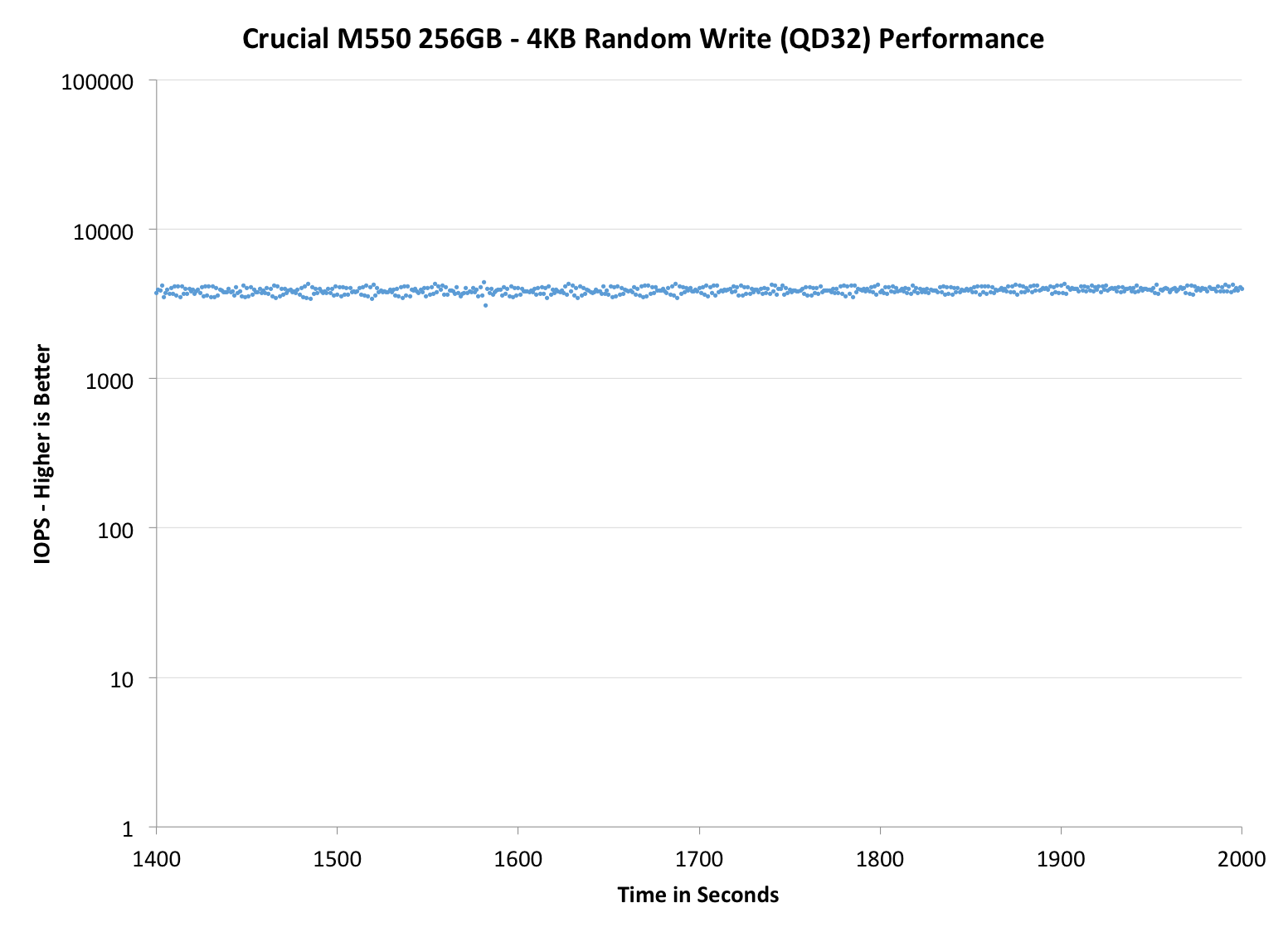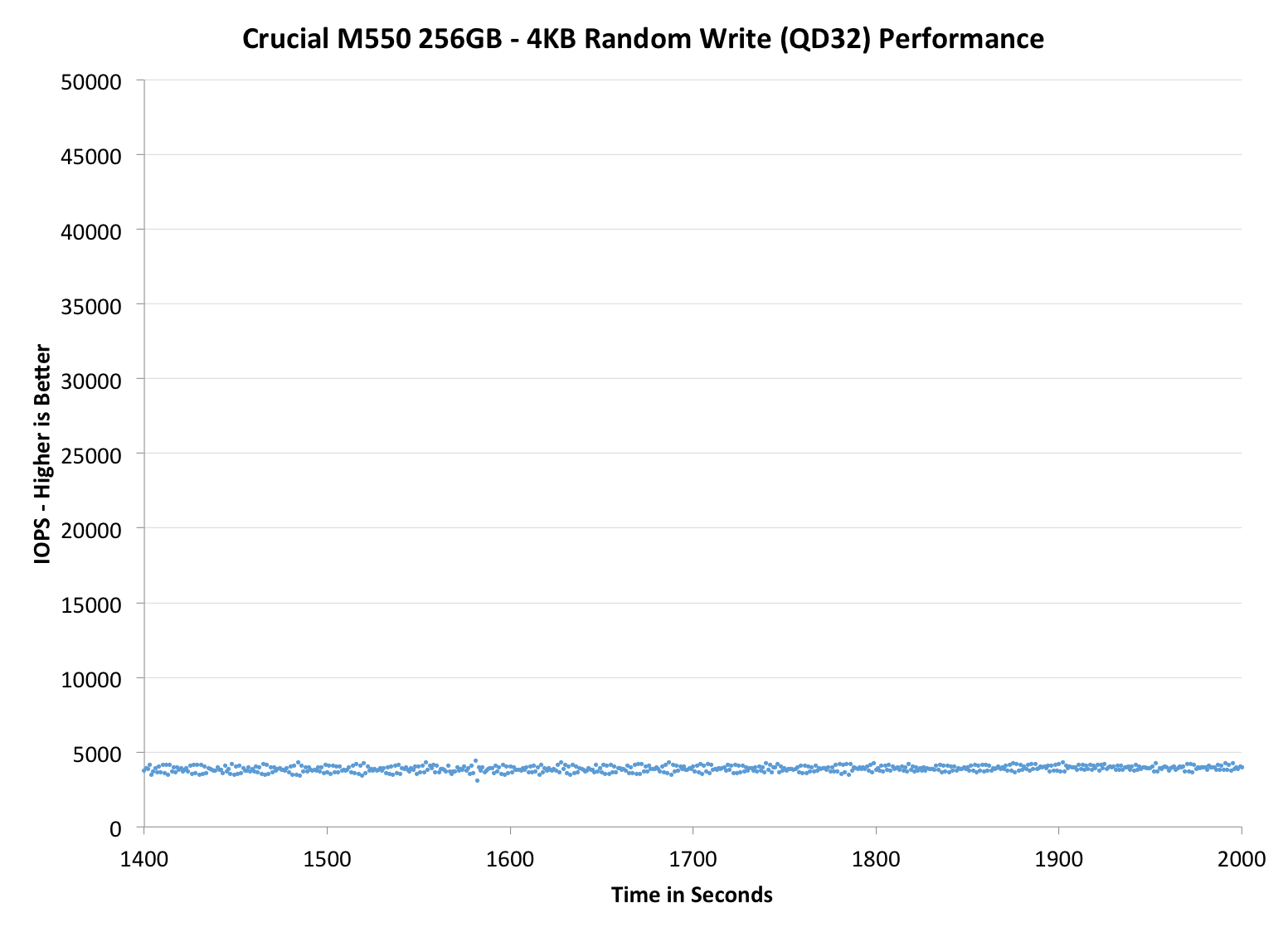Crucial M550 Review: 128GB, 256GB, 512GB and 1TB Models Tested
by Kristian Vättö on March 18, 2014 8:00 AM ESTPerformance Consistency
Performance consistency tells us a lot about the architecture of these SSDs and how they handle internal defragmentation. The reason we don’t have consistent IO latency with SSD is because inevitably all controllers have to do some amount of defragmentation or garbage collection in order to continue operating at high speeds. When and how an SSD decides to run its defrag or cleanup routines directly impacts the user experience as inconsistent performance results in application slowdowns.
To test IO consistency, we fill a secure erased SSD with sequential data to ensure that all user accessible LBAs have data associated with them. Next we kick off a 4KB random write workload across all LBAs at a queue depth of 32 using incompressible data. The test is run for just over half an hour and we record instantaneous IOPS every second.
We are also testing drives with added over-provisioning by limiting the LBA range. This gives us a look into the drive’s behavior with varying levels of empty space, which is frankly a more realistic approach for client workloads.
Each of the three graphs has its own purpose. The first one is of the whole duration of the test in log scale. The second and third one zoom into the beginning of steady-state operation (t=1400s) but on different scales: the second one uses log scale for easy comparison whereas the third one uses linear scale for better visualization of differences between drives. Click the buttons below each graph to switch the source data.
For more detailed description of the test and why performance consistency matters, read our original Intel SSD DC S3700 article.
 |
|||||||||
| Crucial M550 | Crucial M500 | Intel SSD 730 | SanDisk Extreme II | Samsung SSD 840 EVO | |||||
| Default | |||||||||
| 25% Spare Area | - | ||||||||
I can't say I'm very pleased with the IO consistency of the M550. There is a moderate increase (~4K IOPS vs 2.5K in M500) in steady-state performance but other than that there isn't much good to say. All the other higher-end drives run circles around the M550. I should note that the M550 does have considerably less over-provisioning than the other drives but even at 25% OP the results aren't pretty. There is huge variation in performance and the graphs with additional spare area certainly look quite abnormal, but the IOPS is still mostly below 5000. There are peaks of over 50K IOPS too but personally I would prefer a steady line (like the SSD 730) instead of this constant up and down. In client workloads the variation in IOPS isn't as critical as in the enterprise (where predictable performance is a must) but there can be an impact on performance in IO intensive scenarios.
 |
|||||||||
| Crucial M550 | Crucial M500 | Intel SSD 730 | SanDisk Extreme II | Samsung SSD 840 EVO | |||||
| Default | |||||||||
| 25% Spare Area | - | ||||||||
 |
|||||||||
| Crucial M550 | Crucial M500 | Intel SSD 730 | SanDisk Extreme II | Samsung SSD 840 EVO | |||||
| Default | |||||||||
| 25% Spare Area | - | ||||||||
TRIM Validation
To test TRIM, I took a secure erased drive and filled it with sequential data. Then I tortured the drive with 4KB random writes (QD32) for 30 minutes followed by a TRIM command (quick format in Windows). Finally I measured performance with HD Tach to bring you the graph below:
And as you should expect, TRIM works.











100 Comments
View All Comments
hojnikb - Thursday, March 20, 2014 - link
I'm guessing there is lots of headrom in the marvell controler (seeing how other marvell drives perform) so there is a possibilty that they could squeze out a little bit more. But thats all on crucial.But i wouldn't call it quits, because with m4, they did boost read performance quite a bit after the lauch. Time will tell i guess.
nick2crete - Friday, March 21, 2014 - link
Thanks,just got one M550 256gb ,i have also the Samsung 840 pro ,to be honest i didnt see any performance difference ,ok i have them in Marvell 9230 pci e x2 controller and is well known that Samsung dont like Marvell controllers ..but still ..
emn13 - Thursday, March 20, 2014 - link
I guess expectations are everything. The m500 is the cheapest drive available at large size at the moment; with good features, and mediocre performance I think of it as a kind of baseline - if you can't beat the M500, then what's the point?So I guess the M550's fate really comes down to price, and time will tell how that goes.
trichome333 - Wednesday, March 19, 2014 - link
I finally went SSD with a 240gb M500 for $115 and Prime from Amazon. Went ahead and did a fresh install and Windows 7 literally loads in seconds after the logo on the dark screen forms. I think it restarts too fast as my BIOS post screen kinda sets there for a second before posting on restart. BF4 loads went from 2-3 minutes to 20 seconds. I coudnt be more happy coming from SATA II 7200k HDDs. We have several machines around the house and mine is mainly gaming so I dont do many big writes or convert video. What Ive noticed is huge increases and would advise anyone on the fence to make the move. M500 will be PLENTY for 99% of all users IMO.hojnikb - Wednesday, March 19, 2014 - link
Install Windows 8/8.1 and your boot time will be even shorter. Couple that with an uefi capable board and you can get near instant boot.nathanddrews - Wednesday, March 19, 2014 - link
Yeah, but then he'd have Windows 8 and lose all that productivity.hojnikb - Wednesday, March 19, 2014 - link
Meaning what ?mikato - Thursday, March 20, 2014 - link
The whole review is like "meh" and then BAM, look at that pricing. Ok thenDeath666Angel - Friday, March 21, 2014 - link
Any chance you could update the SSD Slumber Power chart with values for the other sizes? Seems weird to just have the smallest SSD in there, when capacity clearly adds to consumption.Hrel - Tuesday, March 25, 2014 - link
" can't say I'm very pleased with the IO consistency of the M550. There is a moderate increase (~4K IOPS vs 2.5K in M500) in steady-state performance but other than that there isn't much good to say. " What are you talking about? The Samsung is the only other 256GB drive in there and it's less consistent than the Crucial. Am I missing something? Those consistency numbers look great!